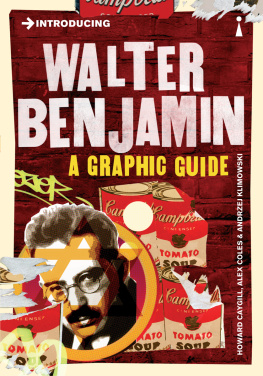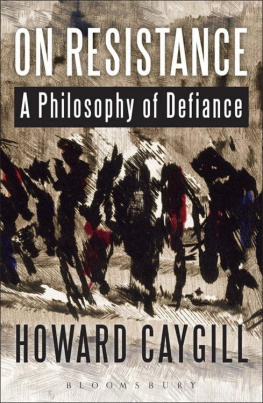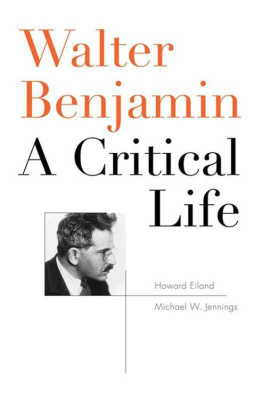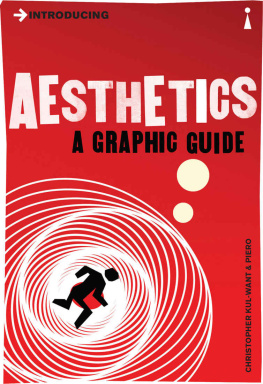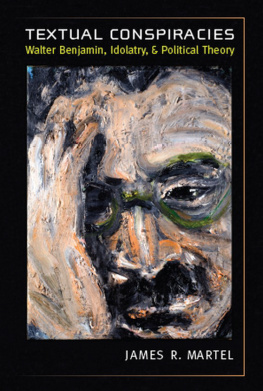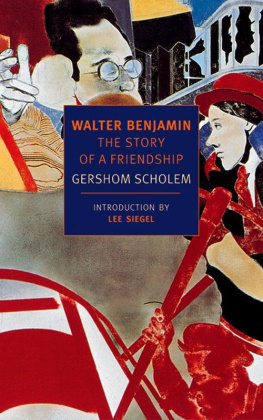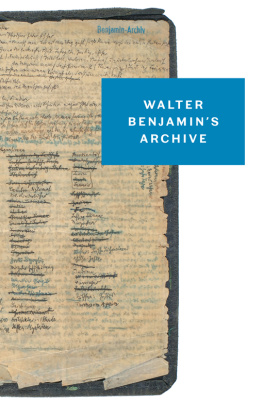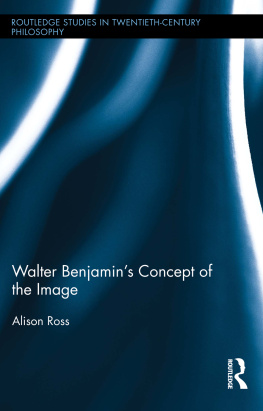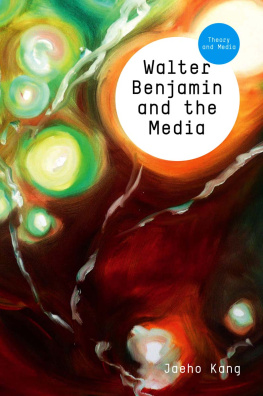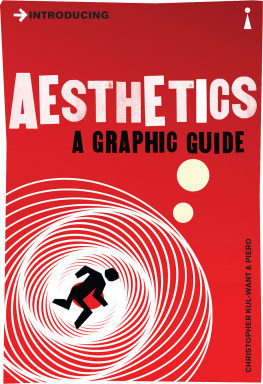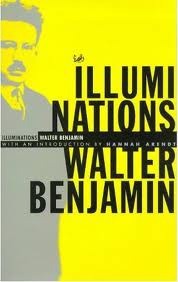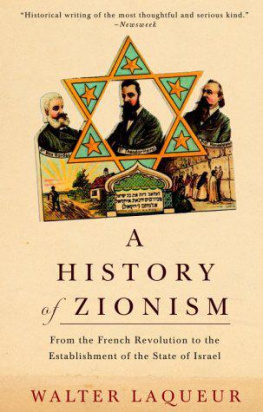Contents
Published by Icon Books Ltd, Omnibus Business Centre, 3941 North Road, London N7 9DP
Email:
www.introducingbooks.com
ISBN: 978-178578-019-6
Text copyright 2012 Icon Books Ltd
Illustrations copyright 2012 Icon Books Ltd
The author and illustrator has asserted their moral rights
Originating editor: Richard Appignanesi
No part of this book may be reproduced in any form, or by any means, without prior permission in writing from the publisher.
THE PASSIONATE CRITIC
Walter Benjamin eludes classification. He seemed content with the name critic. But an exceptional critic of such passion, erudition and virtuosity who transforms the nature of what usually passes for criticism. His gaze is multiple: philosophy, language, art, architecture, photography, history, Jewish mysticism, Marxism. He does not merely glance at these but digs to their foundations.
Every image of the past that is not recognized by the present as one of its own concerns threatens to disappear irretrievably.
If this book can help the reader through the dazzling maze of Benjamins work, it will be at the end to find Benjamin the allegorist.
SNAPSHOTS OF A BERLIN CHILDHOOD
Walter Benjamin was born 15 July 1892 in Berlin. His parents were Emil, a businessman, and his wife Pauline, ne Schnflies. They were Jewish, unassimilated to Christianity, but like many others not strictly observant.
Although it was a peaceful childhood, I was strangely haunted by it for the rest of my life.
He remembered his childhood experiences in a series of memoirs written when he was contemplating suicide in 1932, Berlin Chronicle and A Berlin Childhood Around 1900. The hybrid nature of these texts at once cultural criticism and personal reflection exemplifies the complexity of Benjamins writings which transgress disciplinary borders and rules of genre.
Benjamin presents his memories in the form of snapshot mosaic images, a practice which anticipates his later comments on the philosophy of history. He remembered himself walking reluctantly half a step behind his mother while out shopping.
This was the origin of my habit of seeming slower and more stupid than I actually am
In another image Benjamin remembered seeing a sandwich man vainly trying to give away leaflets.
This first alerted me to the existence of the poor outside of my privileged childhood
He recalled with particular pleasure reading the latest edition of the New Companion to German Youth with its hunting and spy stories which he read illicitly under the bed-covers at night.
Many of these recollected images are tinged with a sense of catastrophe and desperation, such as the flood disaster which left the young Benjamin abandoned on the main shopping boulevard of Berlin, the Kurfrstendamm.
I felt particularly exposed to the elemental power of nature which made the city seem like a primeval forest
While composing his memoirs, Benjamin was partial to hashish and some images show the influence of this: such as his recollection of the Berlin victory column in the park, associated with the words: O brown-baked column of victory/with childrens sugar from the winter days. Death haunts these images.
My father entered my bedroom at night with news of a relatives death. He used a strange word that I forgot. syphilis.
Here we find an example of Benjamins characteristic insight: the manifestation of death in little things.
For all of his life, Benjamin carried with him a horror and fascination for the luxuriously appointed bourgeois interior the over-furnished drawing-room.
These interiors seemed to eat up their inhabitants and digest them into the luxurious furnishings
Although affluent, these interiors were not comfortable. As Benjamin said, They had no space for dying which is why their owners died in a sanatorium, while the furniture went straight to the second-hand dealer.
Benjamins encounter with art began early, with him posing for individual and family photographs.
I remember being perplexed by the demand that I should look like myself
This was particularly difficult when he had to pose in front of a crudely painted backdrop of the Alps, holding a walking stick, bareheaded, sporty, and gazing into the distance with a tortured smile on his lips.
The magnitude of his torments at home and at the photographers studio faded before those of school. He attended the Kaiser Friedrich School in Berlins wealthy Charlottenberg west-end, where he enjoyed a relatively privileged education. The name of the school reflected the attitudes of the staff and the content of the curriculum. The ethos of the German Imperial Army was ever-present, along with a commitment to unremitting industry: If I rest, I rust. The teachers were a strange crew of Imperial parodies who did not recognize the future brilliance of their pupil. They found him well-behaved but with inadequate handwriting.
Benjamins horror of the discipline of school its routines, rituals and daily humiliation moved his parents to send him for two years to an experimental school in the country at the age of 14. At the Haubinda school in Thuringia, Benjamin was taught by the educational reformer Gustav Wyneken.
He was one of the most important influences on me
Wyneken introduced Benjamin to the blossoming Youth Movement in Germany which consisted of various separate groups and organizations of young people.
These ranged from clubs of hikers and ramblers to vaguely anarchistic groups such as the one Wyneken encouraged Benjamin to join. But there were also anti-Semitic and proto-Nazi bands, for example the Youth League of the Imperial Faithful. Benjamin became a teenage rebel, travelling the country giving lectures and writing in the youth fanzines on the need for the young to follow their own inclinations.

